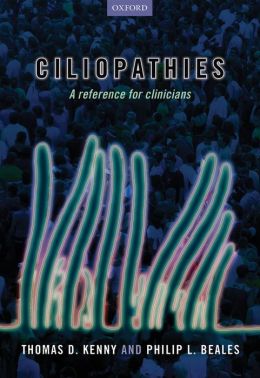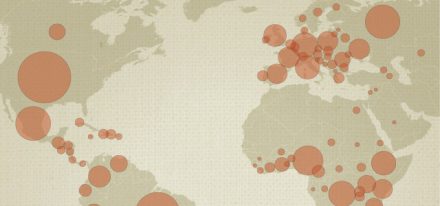 Editors: Thomas D. Kenny and Philip L. Beales
Editors: Thomas D. Kenny and Philip L. Beales
Publisher: Oxford University Press
Book Review by: Nano Khilnani
This book shows us that it is important for physicians in general and these specialists in particular in the following fields -: cardiology, diabetes, nephrology, and ophthalmology – to learn about ciliopathies
Ciliopathies should also be of concern to obstetricians as they have been found to cause abnormalities and load to deaths in babies. For example, in an article entitled Gene Causing Fetal Abnormalities Exposed in the June 1, 2010 issue of The Health Age, Professor Colin A. Johnson of the University of Leeds (who contributed chapter 7 to this book) has done research on two profoundly disabling ciliopathies: the Meckel-Gruber syndrome and Joubert syndrome.
The article points out that these two syndromes are part of wider family of disorders known as ciliopathies. They’re called so because the cilia – a cell’s finger-like antenna – do not always work as they should, and do not respond to signals. Such findings also point to more common disorders such as polycystic kidney disease and spina bifida.
Spina bifida is one of the most common birth defects that affects one in about every 1,000 children, and by understanding the science behind these comparatively rare conditions, researchers could gain insight into other developmental conditions that are less serious but far more common, explains lead researcher Colin A. Johnson
He further stresses that lack of communiqué can avert the neural tube from developing properly that leads to irregularities in the brain. The affected embryos could also develop irregularities in the eyes; develop extra fingers or toes and multiple cysts in their kidneys.
Those defects were detected as early as in the first 12 weeks of fetus development through an ultrasound scan. In the gene accountable for the Meckel-Gruber and Joubert syndromes, the researchers investigated the DNA of the families with a history of these conditions.
They investigated skin cells donated by the patients and from laboratory-grown cells. The results of investigation recognized an unknown gene called TMEM216. This gene causes Meckel-Gruber and Joubert syndromes. Researchers also demonstrated that the faulty version of this gene clogged cells from producing a protein that is required for signaling.
The list of chapters below will give you names of syndromes you probably have not dealt with, just occasionally heard of, or probably not at all.
- Towards the diagnosis of a ciliopathy
- Alstrom syndrome
- Jeune syndrome and the ciliary chondrodysplasia
- Joubert syndrome and Joubert syndrome-related disorders
- Bardet-Biedl syndrome
- Leber congenital amaurosis and other non-syndromic retinal ciliopathies
- Meckel-Gruber syndrome
- Nephronophthisis
- Oral-facial-digital type I syndrome
- Autosomal dominant polycystic kidney disease
- Autosomal recessive polycystic kidney disease
- Primary ciliary dyskinesia
- Usher syndrome
- Syndromes not yet proven to be ciliopathies
This is followed by a list of abbreviations that are probably also unfamiliar to you, such as: ACLs or acrocallosal syndrome; DKA or Dekaban-Arima syndrome; GCPs or Grieg cephalopolysyndactyly syndrome and HLS or hydrolethalus syndrome.
A helpful 6-page list of genes follows that provides much crucial information on understanding ciliopathies and ciliopathy-related disorders. The table provides you the Gene ID, Syndrome, Type of protein encoded, and Function in cilia biology.
This is a valuable book on a lesser-known group of disorders in the medical and research communities known as ciliopathies. The editors Kenny and Beale have led a pioneering effort with this book in a field that still requires much “digging” to understand the causes and effects. We also commend the contributors to this book named below for their initiatives in their particular specialties.
Editors:
Thomas D. Kenny
Affiliated with National Institute for Health Research Evaluation, Trails and Studies Coordinating Centre, University of Southampton, UK
Philip L. Beales
Professor of Medical and Molecular Genetics at UCL Institute of Child Health, London, UK. He s also affiliated with Wellcome Trust as Senior Research Fellow in Clinical Science; Director of the Centre for Translational Genomics (GOSgene) and Head of the Cilia Disorders Laboratory at the UCL Institute; Consultant in clinical genetics at Great Ormond Street Hospital for Children and Guys Hospital; National lead for the Department of Health specialist-commissioned Bardet-Biedl syndrome clinical and diagnostic service; and Chairman of the UCL Rare Diseases Steering Committee and co-editor in Chief of CILIA.
Contributors:
Kate Baker, Philip L. Beales, Carsten Bergmann, Maria Bitner-Glindzicz, Elizabeth Forsythe, Brunella Franco, Victoria Harrison, Claire Hogg, Colin A. Johnson, Thomas D. Kenny, Andrea H. Nemeth, Richard Paisey, Ronald R. Roepman, Zubin Saihan, Richard Sandford, John A. Sayer, Miriam Schmidts, Shalab Srivastava, and Gabrielle







